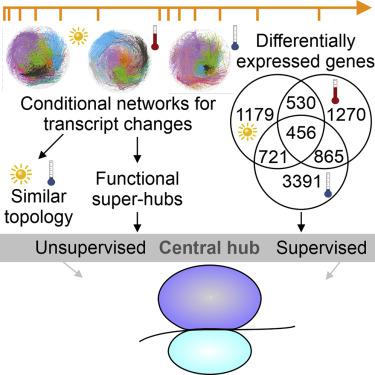iScience ( IF 5.8 ) Pub Date : 2020-07-01 , DOI: 10.1016/j.isci.2020.101331 Antoni Garcia-Molina 1 , Tatjana Kleine 1 , Kevin Schneider 2 , Timo Mühlhaus 2 , Martin Lehmann 1 , Dario Leister 1

|
Plant metabolism is broadly reprogrammed during acclimation to abiotic changes. Most previous studies have focused on transitions from standard to single stressful conditions. Here, we systematically analyze acclimation processes to levels of light, heat, and cold stress that subtly alter physiological parameters and assess their reversibility during de-acclimation. Metabolome and transcriptome changes were monitored at 11 different time points. Unlike transcriptome changes, most alterations in metabolite levels did not readily return to baseline values, except in the case of cold acclimation. Similar regulatory networks operate during (de-)acclimation to high light and cold, whereas heat and high-light responses exhibit similar dynamics, as determined by surprisal and conditional network analyses. In all acclimation models tested here, super-hubs in conditional transcriptome networks are enriched for components involved in translation, particularly ribosomes. Hence, we suggest that the ribosome serves as a common central hub for the control of three different (de-)acclimation responses.
中文翻译:

平移成分有助于拟南芥对强光,高温和寒冷的驯化响应。
在适应非生物变化过程中,植物代谢被广泛地重新编程。以前的大多数研究都集中在从标准压力状态到单一压力状态的转变。在这里,我们系统地分析了适应过程对光,热和冷胁迫的影响,这些过程会微妙地改变生理参数,并评估去适应过程中的可逆性。在11个不同的时间点监测代谢组和转录组的变化。与转录组变化不同,除非冷适应,否则代谢物水平的大多数变化都不会轻易恢复到基线值。相似的监管网络在对强光和寒冷的适应(去适应)过程中运行,而热和强光响应表现出相似的动态,这由意外和有条件的网络分析确定。在此处测试的所有适应模型中,条件转录组网络中的超级枢纽丰富了翻译中涉及的成分,尤其是核糖体。因此,我们建议核糖体作为控制三个不同(去)适应反应的共同中心枢纽。



























 京公网安备 11010802027423号
京公网安备 11010802027423号